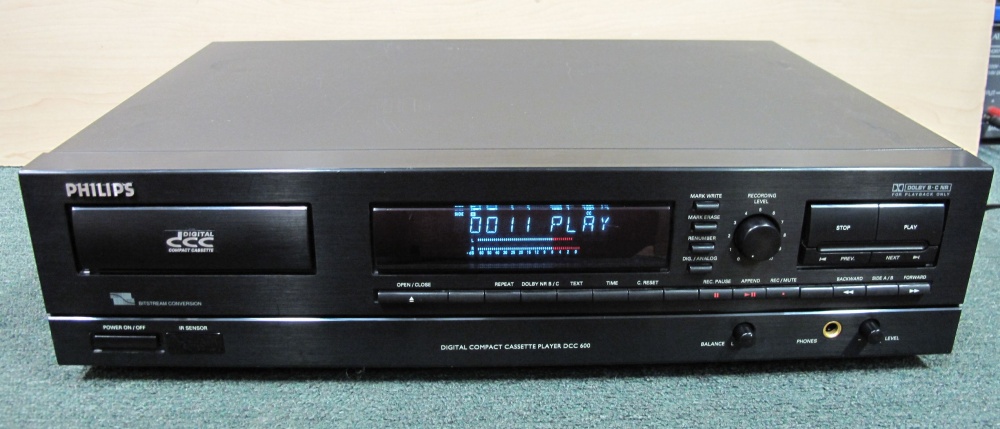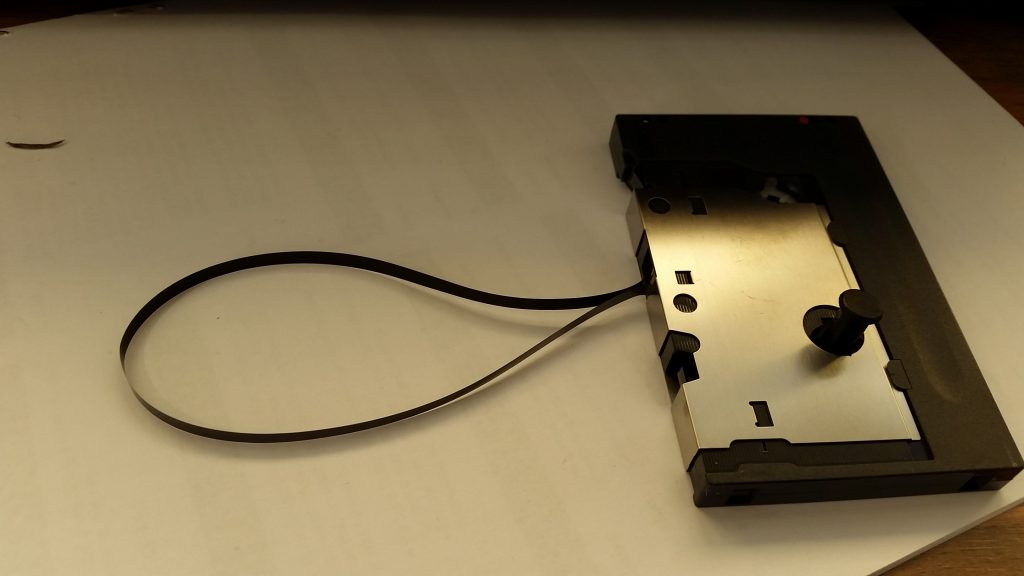A box of DCC tapes
I have lying around a box with +/- 50 used DCC tapes that I purchased a while ago. DCC is the Digital Compact Cassette, invented by Philips. I have gone through them all, I listened to some of the tracks on each tape and sorted which ones I wanted to keep because of what was recorded on it. But most of them could be recorded over.
history
In my youth I had the privilege to experience the evolution of the compact cassette (CC), also a Philips invention btw. It had just made its way from dictafoon-like devices to the hifi/consumer audio market. And I witnessed its rise to a high end audio device (Nakamichi et al.). I have lots of CC tapes, probably my entire youth is recorded on those.
Then, in 1992, DCC came. But by that time, I had lost interest in recording music, or audio as a whole for that matter. So I never really noticed at that time. Also the Sony Mini-disc and DAT recorders went completely past me.
But when I rediscovered my audio hobby around 2010, I got very interested in these three now obsolete recording techniques. And fortunately you can get these devices rather cheap these days.

My Philips DCC600
I have all three devices now.
DCC surprised me in a very positive way. I got the same, familiar feeling playing cassettes that I had back then and that I had gotten used to. Also the deck that I got feels very solid and tape handling is direct. The DCC cassettes themselves feel very, very well thought about. Even the casing and the jewel box is outstanding well designed, even more so the prerecorded tapes.
On top of that, you get CD like audio quality. I say CD like, but I dare you to hear a difference. I was very, very impressed with the whole concept. In hindsight I wish I had used it back then.
squeaking
I noticed when I went through the lot of old tapes however, that some of the DCC tapes were making a squeaking sound when they were played. And some of those would not play at all. The deck, just kept clicking, the drive mechanism reversing a few times, before finally giving up. So I thought that these were bad tapes, or maybe they had some shedding or sticky tape or whatever and that they could not be relied upon. I was resolved to throw them away.
It was clear that it was the tapes that were the problem and not the deck, because most of the tapes would play perfectly and the problem ones would not.
I did some research into cleaning the head of the deck, but found out that this was not a trivial task, and that the fragile head could easily get damaged. The general conclusion was that you don’t clean it, unless it is absolutely necessary because all tapes play bad and it is clearly visibly dirty. So I didn’t.
forum
I researched some more and came across a post on a Dutch forum dedicated to Philips equipment. You can find the post here:
http://www.mfbfreaks.com/forum/viewtopic.php?f=5&t=10492
although I think you need to register first. And it is in dutch 🙂
gunk
It is described there that there are actually 2 problems: the squeaking and stuck tape. The squeaking problem is related to two pieces of felt that are inside the DCC cassette, not visible from the outside. There is also a third piece of felt, this is the familiar one that presses the tape on the head. The 2 problematic felts are located near the left and right rollers located inside the cassette:
.jpg)
These felt pads leave behind a greasy spot on the backside of the tape when the tape is not used for a long time. The deck has trouble running the tape past these spots and finally gives up. This spot is somewhat greasy, but also a bit sticky. This can be observed by pulling the tape somewhat from the cassette and checking the backside. It is not necessary to open the tape casing for this.
 In order to do that, you must pull back the sliding cover and pull the tape out very, very gently with a small tool and make sure that you do not damage or crinkle the tape. You can see the gunk if you look very carefully. Let light shine on the surface. Make sure that the tape is at the problem spot when you stopped the deck and pulled the tape out, from BOTH reels.
In order to do that, you must pull back the sliding cover and pull the tape out very, very gently with a small tool and make sure that you do not damage or crinkle the tape. You can see the gunk if you look very carefully. Let light shine on the surface. Make sure that the tape is at the problem spot when you stopped the deck and pulled the tape out, from BOTH reels.
It was impossible to make a good photo of this, so you will have to look for this yourself.
cleaning
In order to clean the tape, make sure you gently use some non residu cleaner, like IPA or alcohol or videospray cleaner 90 or whatever fits you, and gently rub the problem spot using a cotton swab. Hold the tape down while you swab, careful not to damage or wrinkle the tape. That happens so easily! Remember it’s the backside of the tape.
After that, let the tape dry for a moment, simply wind the tape back inside the housing and play the tape. Voila! It’s working again!
squeaking
For the squeaking problem: I fixed this by cleaning the felt located opposite the head as well. It won’t get completely clean, but just try to clean it as much as possible. I did it with a cotton swab with IPA. Just rub it a lot and also twist the cotton swab over the surface of the felt. Let the felt dry, this will take some minutes, and wind the take back inside.
After that, the squeaking was gone.
more tips
- Always rewind the tape completely before you unload and store it for a longer period. The (clear) leader tape, that’s what the felt presses against when the tape is rewound, doesn’t seem to have as much problem with the grease.
- Also don’t demagnetize the head! Never! It will ruin it forever. The head does not require demagnetization.
- Never ever use a cleaning cassette. The head is way too fragile and it will ruin it forever.
- If you absolutely have to clean the head, use alcohol or IPA . Preferably with natural chamois leather, but a cotton swab will work as well.
Update: since I wrote this article, I *have* cleaned the heads of my DCC decks. Several times. No problem. Just use a cotton swab with IPA and be very gentle. I have taken out the mechanism however. See also my video: - Avoid playing normal (analog) compact cassettes in a DCC player. Normal cassettes are not as clean as DCC cassettes because they have no tapeprotection and will make the head and the drive mechanism dirty. But most of all the tape formulas used in the analogue tapes are not as good as in the DCC and will shed oxide on the head. Better safe than sorry!
- See an other post of mine https://www.reeltoreel.nl/blog/?p=809 where I explain the tape length identification marks on the DCC cassette.
All info and the picture of the open DCC cassette are from the forum mentioned.
See also my new post here:

Thank You very much for this information!! I went through the same experience when I plugged my DCC 900 and brought out my collection of cassettes, after a long period of time. It was mainly the squeaking issue that was driving me crazy, and your solution solved the problem!! I haven’t experienced the problem of the tape transport stopping because of the greasy/sticky residue left on the backside of the tape (yet!). Thanks to you, if it happens, I’ll know what to do!! I got into this format long after it had been discontinued, but I did manage to find a new in box DCC 900 about 15 years ago at a very low price. It hasn’t been used much, but I’m sure it will soon begin to show signs of the leaking surface mount capacitors. In any case, I’ll have some fun with it till then!! Thanks again!!
Ken
Pingback: Treating old DCC tapes for the first time | www.reeltoreel.nl